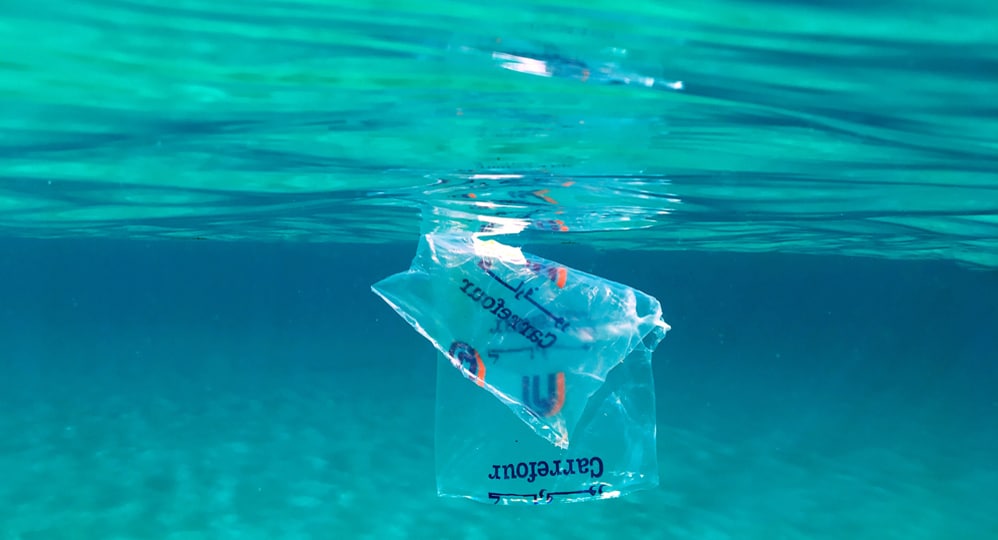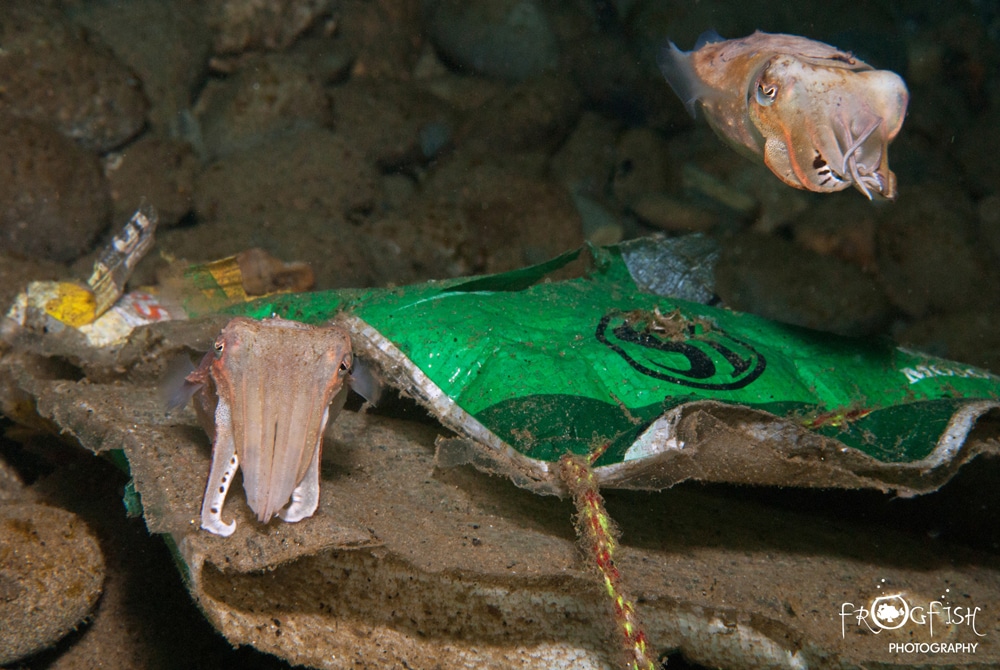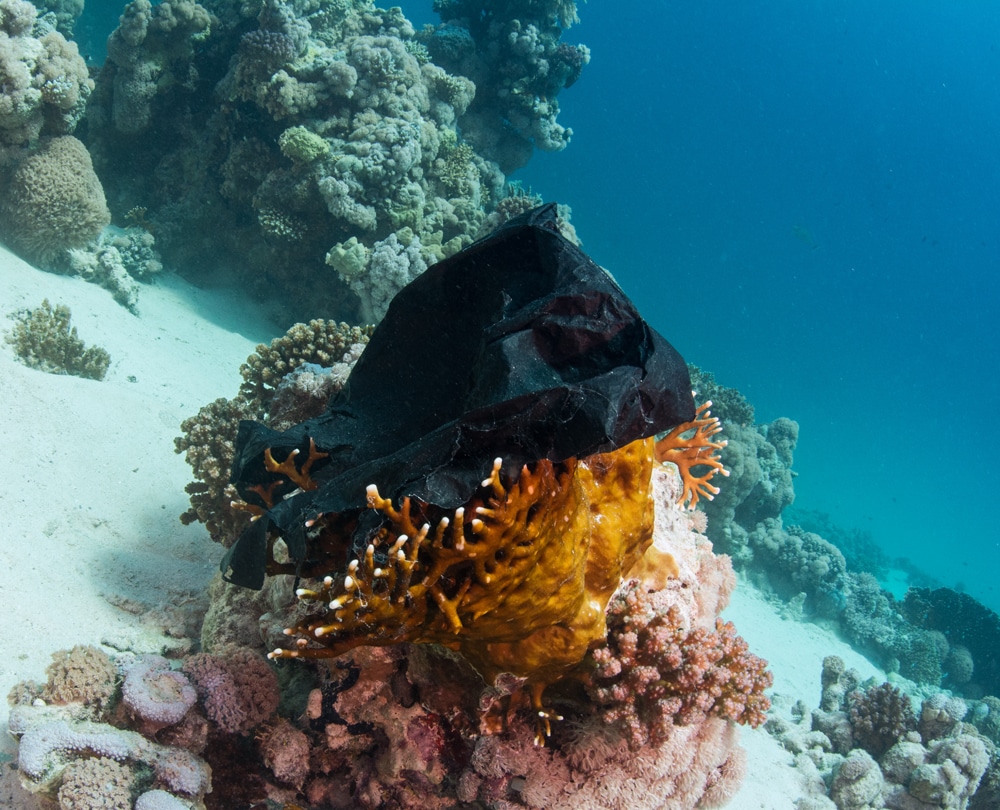Marine Life & Conservation Blogs
Is the Dive industry doing enough to tackle plastic pollution?

Plastic pollution has finally hit the news and whilst the task ahead is still huge, there are signs that the tide is changing for plastic polluting our seas and oceans. In the UK, there has been a “Blue Planet Effect” where one extremely popular TV series has had a profound influence on the way people think about the plastic they use. On top of this with Sky TV running a campaign on their sporting channels and the mainstream TV and paper news outlets finally bringing the problem into our sitting rooms, the public and politicians are taking note and starting to act.
What is the problem?
Well – all the plastic that has ever been made still exists. It might break down into smaller and smaller pieces, but it never goes away. Here are some more sobering facts:
- Over 8 million tonnes of plastic ends up in the ocean every year.
- The UN estimates that there are 51 trillion microplastic particles in the ocean – 500 times more than the number of stars in the galaxy. Plastic debris outweighs plankton by a ratio of 36 to 1. Oceans are predicted to contain more plastic than fish by 2050.
- More than 5 trillion plastic pieces weighing over 250,000 tonnes afloat at sea. In July 2017, a plastic waste patch bigger than Mexico was discovered floating in the Pacific Ocean.
- Plastic products leach toxins that are now found in most people. Exposure to these toxins is linked to infertility, cancers and many other health problems.
- In 2016, 6,000 Great British Beach Clean volunteers picked up 268,384 individual pieces of plastic from 364 British beaches over just one weekend.
Wild animals get entangled in plastic, eat it or mistake it for food and feed it to their young. Over 260 species have been reported to ingest or become entangled in plastic debris, resulting in impaired movement and feeding, reduced reproductive output and death. Plastic is ingested by 31 species of marine mammal and more than 100 species of sea birds.
So what are divers doing to help?
Lots – but there is so much more to do! Of course, divers are usually passionate about the oceans and marine life, so can be the best advocates for promoting the idea of giving up single-use plastic.
Our very own Nick and Caroline Robertson-Brown helped to set up a campaign called SeaStraw that is helping bars and restaurants give up single-use plastic and they are having great success in Manchester where they live. Businesses can download and sign their pledge from the website, putting themselves on the Ocean Heroes Map, by clicking here.
We recently ran a story about a liveaboard fleet that has given up plastic straws and aims to be single-use plastic free by 2019. You can read about that here: www.scubaverse.com/liveaboard-fleet-makes-plastic-pledge
Lots of dive centers, resorts and liveaboards we have recently dived with are giving away re-usable water bottles, rather than single-use plastic cups.
Many dive centres organise beach clean-ups to remove plastic pollution from the shoreline and even underwater.
Charities such as Project Aware and the Marine Conservation Society collect both rubbish and vital data about plastic pollution in our oceans.
But there is more that can be done, and it will take divers to speak up, celebrating the good as well as calling out bad practices to help us stamp out plastic pollution in our oceans. For example, email your favourite dive manufacturer and ask them to use less plastic in their product packaging. Refuse single-use plastics like straws and cups from the bars and restaurants you frequent on diving trips and in every day life. Don’t take part in balloon releases. Every little thing you do will help.
Contact Us
We want to know what you have encountered on your dive trips around the world. What great initiatives have you seen? Please give a shout out to the dive establishments that are doing their bit and give them the recognition they deserve. If you run a dive centre and are doing your bit – let us know.
Marine Life & Conservation Blogs
Creature Feature: Dusky Shark

 In this series, the Shark Trust will be sharing amazing facts about different species of sharks and what you can do to help protect them.
In this series, the Shark Trust will be sharing amazing facts about different species of sharks and what you can do to help protect them.
This month we’re taking a look at the Dusky Shark, a highly migratory species with a particularly slow growth rate and late age at maturity.
Dusky sharks are one of the largest species within the Carcharhinus genus, generally measuring 3 metres total length but able to reach up to 4.2 metres. They are grey to grey-brown on their dorsal side and their fins usually have dusky margins, with the darkest tips on the caudal fin.
Dusky Sharks can often be confused with other species of the Carcharhinus genus, particularly the Galapagos Shark (Carcharhinus galapagensis). They have very similar external morphology, so it can be easier to ID to species level by taking location into account as the two species occupy very different ecological niches – Galapagos Sharks prefer offshore seamounts and islets, whilst duskies prefer continental margins.
Hybridisation:
A 2019 study found that Dusky Sharks are hybridising with Galapagos Sharks on the Eastern Tropical Pacific (Pazmiño et al., 2019). Hybridisation is when an animal breeds with an individual of another species to produce offspring (a hybrid). Hybrids are often infertile, but this study found that the hybrids were able to produce second generation hybrids!
Long distance swimmers:
Dusky sharks are highly mobile species, undertaking long migrations to stay in warm waters throughout the winter. In the Northern Hemisphere, they head towards the poles in the summer and return southwards towards the equator in winter. The longest distance recorded was 2000 nautical miles!
Very slow to mature and reproduce:
The Dusky Shark are both targeted and caught as bycatch globally. We already know that elasmobranchs are inherently slow reproducers which means that they are heavily impacted by overfishing; it takes them so long to recover that they cannot keep up with the rate at which they are being fished. Dusky Sharks are particularly slow to reproduce – females are only ready to start breeding at roughly 20 years old, their gestation periods can last up to 22 months, and they only give birth every two to three years. This makes duskies one of the most vulnerable of all shark species.
The Dusky Shark is now listed on Appendix II of the Convention on the Conservation of Migratory Species (CMS), but further action is required to protect this important species.
Scientific Name: Carcharhinus obscurus
Family: Carcharhinidae
Maximum Size: 420cm (Total Length)
Diet: Bony fishes, cephalopods, can also eat crustaceans, and small sharks, skates and rays
Distribution: Patchy distribution in tropical and warm temperate seas; Atlantic, Indo-Pacific and Mediterranean.
Habitat: Ranges from inshore waters out to the edge of the continental shelf.
Conservation status: Endangered.
For more great shark information and conservation visit the Shark Trust Website
Images: Andy Murch
Diana A. Pazmiño, Lynne van Herderden, Colin A. Simpfendorfer, Claudia Junge, Stephen C. Donnellan, E. Mauricio Hoyos-Padilla, Clinton A.J. Duffy, Charlie Huveneers, Bronwyn M. Gillanders, Paul A. Butcher, Gregory E. Maes. (2019). Introgressive hybridisation between two widespread sharks in the east Pacific region, Molecular Phylogenetics and Evolution 136(119-127), https://doi.org/10.1016/j.ympev.2019.04.013.
Marine Life & Conservation Blogs
Creature Feature: Undulate Ray

 In this series, the Shark Trust will be sharing amazing facts about different species of sharks and what you can do to help protect them.
In this series, the Shark Trust will be sharing amazing facts about different species of sharks and what you can do to help protect them.
This month we’re looking at the Undulate Ray. Easily identified by its beautiful, ornate pattern, the Undulate Ray gets its name from the undulating patterns of lines and spots on its dorsal side.
This skate is usually found on sandy or muddy sea floors, down to about 200 m deep, although it is more commonly found shallower. They can grow up to 90 cm total length. Depending on the size of the individual, their diet can range from shrimps to crabs.
Although sometimes called the Undulate Ray, this is actually a species of skate, meaning that, as all true skates do, they lay eggs. The eggs are contained in keratin eggcases – the same material that our hair and nails are made up of! These eggcases are also commonly called mermaid’s purses and can be found washed up on beaches all around the UK. If you find one, be sure to take a picture and upload your find to the Great Eggcase Hunt – the Shark Trust’s flagship citizen science project.
It is worth noting that on the south coasts, these eggcases can be confused with those of the Spotted Ray, especially as they look very similar and the ranges overlap, so we sometimes informally refer to them as ‘Spundulates’.
Scientific Name: Raja undulata
Family: Rajidae
Maximum Size: 90cm (total length)
Diet: shrimps and crabs
Distribution: found around the eastern Atlantic and in the Mediterranean Sea.
Habitat: shelf waters down to 200m deep.
Conservation Status : As a commercially exploited species, the Undulate Ray is a recovering species in some areas. The good thing is that they have some of the most comprehensive management measures of almost any elasmobranch species, with both minimum and maximum landing sizes as well as a closed season. Additionally, targeting is entirely prohibited in some areas. They are also often caught as bycatch in various fisheries – in some areas they can be landed whilst in others they must be discarded.
IUCN Red List Status: Endangered
For more great shark information and conservation visit the Shark Trust Website
Image Credits: Banner – Sheila Openshaw; Illustration – Marc Dando
-

 News3 months ago
News3 months agoHone your underwater photography skills with Alphamarine Photography at Red Sea Diving Safari in March
-

 News3 months ago
News3 months agoCapturing Critters in Lembeh Underwater Photography Workshop 2024: Event Roundup
-

 Marine Life & Conservation Blogs3 months ago
Marine Life & Conservation Blogs3 months agoCreature Feature: Swell Sharks
-

 Blogs2 months ago
Blogs2 months agoMurex Resorts: Passport to Paradise!
-

 Blogs2 months ago
Blogs2 months agoDiver Discovering Whale Skeletons Beneath Ice Judged World’s Best Underwater Photograph
-

 Gear Reviews2 weeks ago
Gear Reviews2 weeks agoGEAR REVIEW – Revolutionising Diving Comfort: The Sharkskin T2 Chillproof Suit
-

 Marine Life & Conservation2 months ago
Marine Life & Conservation2 months agoSave the Manatee Club launches brand new webcams at Silver Springs State Park, Florida
-

 Gear Reviews3 months ago
Gear Reviews3 months agoGear Review: Oceanic+ Dive Housing for iPhone
























